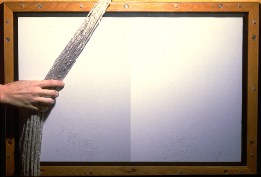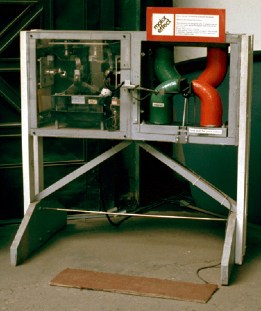| understand nature and its effects on people. The art in the Exploratorium is therefore blended with the science as a part of the overall pedagogy. These works, that derive primarily from aesthetic considerations, undoubtedly also play a crucial role in our ability to attract a universal audience. We need to do more along these lines, but we are slow in doing so because we only accept those artists whose interests mesh with the broad thematic content of the museum. The Design of Specific Exhibits The creation of virtually everyone of our exhibits has involved multiple stages of decision making about how best to demonstrate a particular idea or phenomena, about how much variation to provide for the basic variables and about how much random irrelevant behavior to retain in the design. | Each half changes from light to slightly darker across the rectangle. The rope hides the discontinuity between them, the step that goes abruptly from dark to light. )The exhibit as it stands is a good one and does not need anything more. We do however have nearby another exhibit, a rotating vertical cylinder with vertical black and white stripes that illustrates the same effect. The first exhibit was copied after one in Edwin Land's research laboratory and the second version was suggested by one at the MIT teaching laboratory. Although the single activity of the Gray Step exhibit is satisfactory, many of the single activity exhibits in our electricity section are extremely disappointing. One of these, Motor Effect, which we really tried to make effective, was conceived to demonstrate the force that a magnetic field exerts on a wire carrying a current. We used an array of radar permanent magnets that we got from the dismantled accelerator at Cal. Tech. They create a magnetic field of over 2000 gauss within a gap of 1-1/2" with pole pieces of area 2" by 10". A very flexible rubber covered wire about 1" in | ||
 | |||
 | |||
| In the Gray Step exhibit, there is really only one thing that the visitors can do. They can move a rope that covers the boundary between two seemingly identical white rectangles to one side. When they do so, one rectangle looks uniformly dark gray and the other a uniform white. The effect is so remarkable that a visitor will repeat the procedure over and over again. In this case, we do not need to provide any other activity. Invariably the visitors will also read the "What is Going On" graphics. (We did, after the exhibit was on display for several years, add a white card with two widely separated holes punched in it. An Explainer can now use the card to show that the identical uniform-looking rectangles are not uniform. | |||
The Motor Effect Exhibit makes the wire in the magnet on the right jump when 200 amperes of current flows through it. | |||